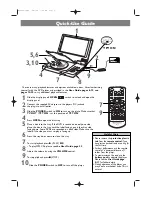
November 16, 2006
6881094C31-E
3-6
Theory of Operation:
Transceiver Board
3.1.2.1 Receiver Front End
NOTE:
Refer to
Table 8-1, “List of Transceiver Schematics and Board Overlays,” on page 8-1
for a
listing of receiver front end schematics.
The receiver front end tunes to the desired channel and down converts the RF signal to the first
intermediate frequency (IF). Channel selection is by way of a tunable local oscillator, RXLO, from the
FGU.
The receiver front end consists of a preselector filter, an RF amplifier, a second preselector, mixer,
and an IF crystal filter. VHF, UHF Range 1and UHF Range 2 radios also contain a switchable
attenuator between the antenna switch and the first preselector filter. The RF amplifier is a discrete
RF transistor with associated circuitry. The mixer is a double-balanced, active mixer IC, coupled by
transformers. The receiver (RX) local oscillator (LO) is provided by the FGU.
3.1.2.1.1 Preselector Filters
VHF, UHF Range 1, and UHF Range 2:
The receiver front end uses two discrete, tunable, bandpass
filters to achieve its required out-of-band rejection. The first preselector filter precedes the RF
amplifier, while the second preselector filter follows the RF amplifier. DAC2, from the PCIC, is used
to simultaneously tune both preselector filters by applying voltage to the varactors.
700–800 MHz:
The receiver front end uses two, multi-layer, ceramic, tunable, bandpass filters to
achieve its required out-of-band rejection. The first preselector filter, FL401, precedes the discrete
RF amplifier. To tune the center frequency of the first filter, voltage from port DAC1 is applied to pin 3
of FL401. Pin 3 connects to the surface-mounted varactor diodes placed on each filter. A second
identical filter, FL402, follows the discrete RF amplifier. The second filter is tuned by applying voltage
from port DAC2 to pin 3 of FL402. Capacitors C409 and C410 are RF bypasses. Capacitors C400
and C411 are used to filter out noise from the DAC1 and DAC2 control lines.
3.1.2.1.2 LNA (Low-Noise Amplifier)
The XTS 5000 radio uses a discrete transistor for the low-noise amplifier (Q428 in VHF, Q430 in
UHF Range 1, Q428 in UHF Range 2, and either Q401 or Q420 (NUF3577C or later) in 700–
800 MHz). A feedback network between the collector and base improves stability and gain balance
across the frequency band. Input and output LC networks match the LNA impedance to 50 ohms.
A diode limiter (D722 in VHF, D400 in UHF Range 1, D722 in UHF Range 2, and D401 in 700-800
MHz) protects the amplifier damage by strong input signals.
3.1.2.1.3 Mixer
The mixer (U451 in VHF, U470 in UHF Range 1, U451 in UHF Range 2 and either U401or
U405
(NUF3577C or later)
in 700–800 MHz) down-converts the received RF to the first intermediate
frequency (IF). The IF is 44.85 MHz for VHF, 73.35 MHz for UHF Range 1 and UHF Range 2, and
109.65 MHz for 7/800 MHz. High-side LO injection is used for VHF and 700 MHz, low-side for the
UHF bands and 800 MHz. Transformers are used as baluns to convert signals from singleended to
balanced at pins MI, MIX, LO, and LOX. An output transformer converts the balanced signal at pins
MO and MOX to a single-ended output.
3.1.2.1.4 IF Filter
The IF filter (FL451 in VHF, FL490 in UHF Range 1, FL451 in UHF Range 2, and FL403 in 700–800
MHz) is a leadless, surface-mount, 3-pole, quartz crystal filter. This narrow bandpass filter gives the
radio its adjacent-channel and alternate-channel rejection performance.
Input and output LC networks match the filter impedance to 50 ohms. Exceptions are the VHF and
UHF Range 2, where the output is matched to 50 ohms, but the input is not.
Summary of Contents for ASTRO XTS-5000
Page 7: ...vi Table of Contents November 16 2006 6881094C31 E Notes ...
Page 11: ...x List of Figures November 16 2006 6881094C31 E Notes ...
Page 17: ...November 16 2006 6881094C31 E xvi CommercialWarranty Notes ...
Page 31: ...November 16 2006 6881094C31 E xxx Portable Radio Model Numbering System Notes ...
Page 83: ...November 16 2006 6881094C31 E 3 44 Theory of Operation Encryption Module ...
Page 135: ...November 16 2006 6881094C31 E 5 44 Troubleshooting Charts Secure Hardware Failure Notes ...
Page 175: ...November 16 2006 6881094C31 E 7 32 Troubleshooting Tables List of Board and IC Signals Notes ...
Page 367: ...November 16 2006 6881094C31 E Glossary 10 Notes ...
Page 373: ...Index 6 November 16 2006 6881094C31 E Notes ...
















































